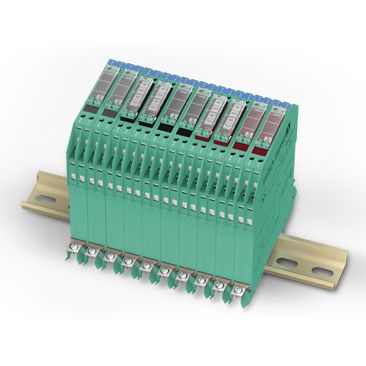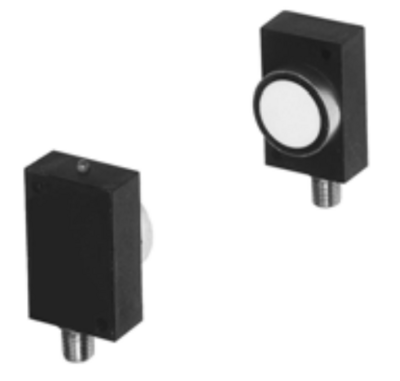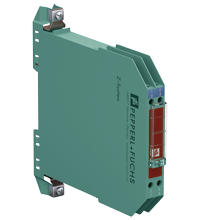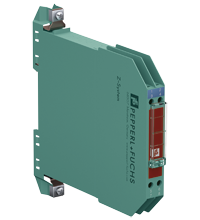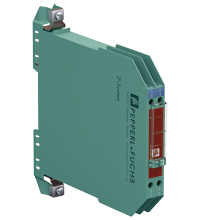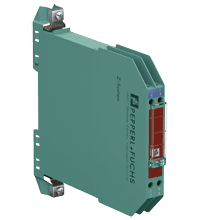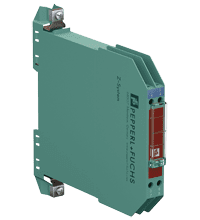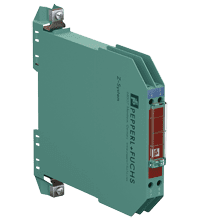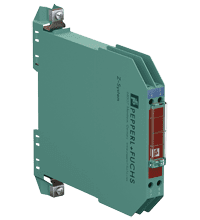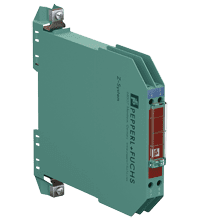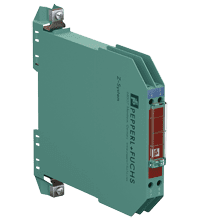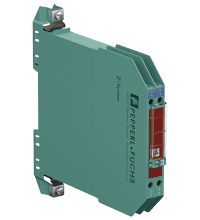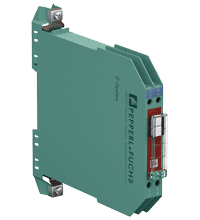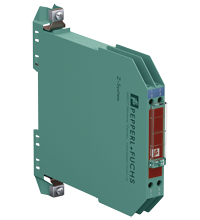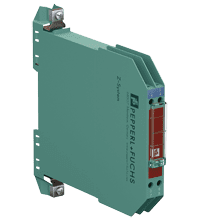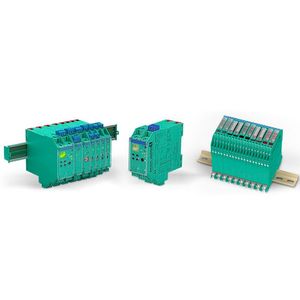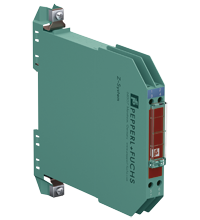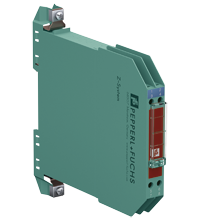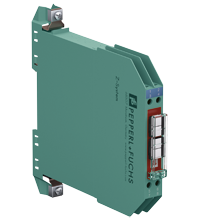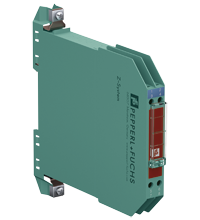Pepperl+Fuchs Zener Barriers
Pepperl+Fuchs UBE150-F64-SE2-V3 ultrasonic fence
- Wide viewing angle: 180°
- Detection distance: up to 1 meter
- Insensitive to dirt and dust: can be used in a variety of environments
- 2-channel
- AC version
- Working voltage 10 V at 10 µ-A
- Series resistance max. 1033 &Omega-
- Fuse rating 50 mA
- DIN rail mounting
- 2-channel
- DC version, positive polarity
- Working voltage 1 V at 1 µ-A
- Series resistance max. 50 &Omega-
- Fuse rating 100 mA
- DIN rail mountable
- 2-channel
- DC version, positive polarity
- Working voltage 6 V at 1 µ-A
- Series resistance max. 2030.5 &Omega-
- Fuse rating 80 mA
- DIN rail mountable
- 2-channel
- DC version, positive polarity
- Working voltage 1 V at 1 µ-A
- Series resistance max. 209.5 &Omega-
- Fuse rating 100 mA
- DIN rail mountable
- 1-channel
- DC version, positive polarity
- Working voltage 0.9 V at 1 µ-A
- Series resistance max. 18.18 &Omega-
- Fuse rating 250 mA
- DIN rail mounting
- 1-channel
- DC version, positive polarity
- Working voltage 6.5 V at 10 micro-A
- Series resistance max. 56 Omega-
- Fuse rating 100 mA
- DIN rail mountable
- 1-channel
- DC version, positive polarity
- Working voltage 13.7 V at 10 micro-A
- Series resistance max. 29 Omega-
- Fuse rating 160 mA
- DIN rail mounting
- 1-channel
- DC version, positive polarity
- Working voltage 13 V at 10 micro-A
- Series resistance max. 107 Omega-
- Fuse rating 100 mA
- DIN rail mounting
- 1-channel
- DC version, positive polarity
- Working voltage 13 V at 10 micro-A
- Series resistance max. 1025 Omega-
- Fuse rating 100 mA
- DIN rail mounting
- Increased nominal resistance 1 k Omega-
- 1-channel
- DC version, positive polarity
- Working voltage 19 V at 10 micro-A
- Series resistance max. 166 Omega-
- Fuse rating 50 mA
- DIN rail mounting
- 1-channel
- DC version, positive polarity
- Working voltage 26.5 V at 10 micro-A
- Series resistance max. 327 Omega-
- Fuse rating 50 mA
- DIN rail mounting
- 1-channel
- DC version, positive polarity
- Working voltage 26.5 V at 10 micro-A
- Series resistance max. 250 Omega-
- Fuse rating 80 mA
- DIN rail mounting
- High power version
- 1-channel
- DC version, positive polarity
- Working voltage 26.5 V at 10 micro-A
- Series resistance max. 273 Omega-
- Fuse rating 50 mA
- DIN rail mounting
- High power version
- Replaceable back-up fuse
- 2-channel
- DC version, positive polarity
- Working voltage 0.9 V at 1 µ-A
- Series resistance max. 18.18 &Omega-
- Fuse rating 250 mA
- DIN rail mounting
- 2-channel
- DC version, positive polarity
- Working voltage 6 V at 10 micro-A
- Series resistance max. 15.5 Omega-
- Fuse rating 200 mA
- DIN rail mounting
- 2-channel
- DC version, positive polarity
- Working voltage 10 V at 10 µ-A
- Series resistance max. 1033 &Omega-
- Fuse rating 50 mA
- DIN rail mounting
- 2-channel
- DC version, positive polarity
- Working voltage 19 V at 10 µ-A
- Series resistance max. 166 &Omega-
- Fuse rating 50 mA
- DIN rail mounting
- 2-channel
- DC version, positive polarity
- Working voltage 26.5 V at 10 µ-A
- Series resistance max. 646 &Omega-
- Fuse rating 50 mA
- DIN rail mounting
- 2-channel
- DC version, positive polarity
- Working voltage 26.5 V at 10 µ-A
- Series resistance max. 250 &Omega-
- Fuse rating 80 mA
- DIN rail mounting
- High power version
- 2-channel
- DC version, positive polarity
- Working voltage 26.5 V at 10 µ-A
- Series resistance max. 273 &Omega-
- Fuse rating 50 mA
- DIN rail mounting
- High power version
- Replaceable back-up fuse
- 2-channel
- DC version, positive polarity
- Working voltage 26.5 V at 10 µ-A
- Series resistance max. 36 &Omega- + 0.9 V
- Fuse rating 50 mA
- DIN rail mounting
- With diode return
Intrinsically safe barriers are an essential part of the Pepperl+Fuchs catalog of electrical safety solutions. These barriers provide protection for electrical signals passing through hazardous areas. The intrinsically safe modules combine the energy-limiting functions of Zener barriers with galvanic isolation. Pepperl+Fuchs produces systems for various purposes and installation methods.
Our most common IS barriers are DIN rail-mounted flexible modules. Zener intrinsically safe barriers are easily connected using a power rail mounted on a DIN rail. The power rail reduces the use of cables due to the inclusion of modules mounted on a DIN rail. Today we will talk about the Pepperl+Fuchs barrier with Zener diodes.
Overview of Pepperl+Fuchs Zener Barriers
The Pepperl+Fuchs intrinsically safe Zener barrier is an electronic safety device (often of modular design) installed in series in a circuit between the intrinsically safe and non-intrinsically safe areas of a plant, in other words, between the hazardous area and the non-hazardous area.
Pepperl+Fuchs Zener barriers must, first of all, satisfy the requirements for intrinsic safety. Therefore, devices for spark protection are traditionally filled with a compound, and such devices are called spark protection units. Unfortunately, there is no provision for repairing the IS barriers - this is the price for safety.
These blocks provided by Pepperl+Fuchs have several advantages: they are versatile, inexpensive, easy to install, have small dimensions and a simple modular design, and are convenient for dense mounting on a DIN rail.
Working Principle of Zener Barriers
Let's take a look at the Zener barriers explained. Like any potentially safe equipment, the Zener diode barrier device provides hazardous area safety. Still, it allows the possibility of a short circuit between cables or between a line and metal-grounded objects without creating a potentially dangerous situation. The interface mode for Zener barrier devices differs from the interface mode for other devices because there is no galvanic isolation.
Thus, cables passing through a potentially hazardous area must share equipment with wires in a safe place. Fulfillment of this requirement assumes the presence of equipotential grounding.
The Zener intrinsically safe is designed to limit the energy that can be generated in a hazardous area, regardless of the type of connection previously installed. The barrier has resistance coils to limit current, Zener diodes to limit voltage, and a fuse to protect these components.
The Zener intrinsically safe barrier interface differs from other methods, as in this case, there is no galvanic isolation: cables running in the hazardous and non-hazardous areas have the same properties. This assumes low resistance and the same ground-mount potential as the barrier.
The intrinsically safe barriers work as follows. In the standard mode of operation of the equipment, the Zener diodes are closed, and the current does not flow through them because the voltage on them has not yet exceeded the breakdown voltage.
But at the moment of the onset of an emergency in the circuit, the voltage on the Zener diodes immediately begins to exceed a specific limit - the Zener diodes abruptly switch to a state of conduction (stabilization mode) - they begin to pass current through themselves actively, shunting the circuit, preventing the appearance of a spark.
A resistor connected in series will limit the current in the protected circuit, and a fuse will prevent the extreme situation - the development of too much wind.
Considerations for Selecting Zener Barriers
Below we will look at what aspects you should consider when choosing Zener barriers from Pepperl+Fuchs.
- Hazardous area classification. Define the hazardous area classification according to the standards and guidelines applicable to your industry. General categories include class I (flammable gases/vapors), class II (combustible dust), and class III (explosive fibers). The Zener barrier you choose must be suitable for the defined hazardous area class.
- Voltage and power rating. Intrinsically safe barriers use zener diodes to control voltage and current levels. The voltage and power rating of the diode must be carefully matched to the expected maximum voltage and current levels in the hazardous area. Ensure the diode you choose can handle potential overloads without breaking down or becoming a fire hazard.
- Voltage compatibility. Ensure the Zener barrier's output voltage is compatible with the equipment you are connecting to in the safe area. It must provide adequate protection without affecting the operation of the connected equipment.
- Mounting and housing. Consider the physical environment in which the Zener barrier will be installed. Choose the appropriate mounting method and enclosure that protects from environmental factors such as moisture, dust, and vibration. The section must meet your application's required degree of protection (e.g., IP67).
- Temperature range. Different hazardous environments may have different temperature ranges. You must ensure that the operating temperature range of the Zener Barrier is within the dangerous area conditions to prevent performance problems.
- Cable length and capacitance. The length and capacitance of the cables connected to the Zener barrier can affect its performance. Consider these factors when designing to avoid signal degradation or instability.
Pepperl+Fuchs Zener Barriers Series.
Pepperl+Fuchs Zener barriers provide cost-effective explosion protection for various process automation applications. The energy transferred to the hazardous area is limited to a safe level that does not ignite an explosive atmosphere.
Zener barriers intrinsic safety in the Z-system range from Pepperl+Fuchs mount directly on a 35 mm DIN rail. With the help of accessories, the necessary grounding can be carried out now on the DIN mounting rail.
In addition, Z-system Zener barriers are available in high density up to 2 channels/12.5 mm wide. Field-replaceable fuse options provide a convenient means of isolating or breaking the instrument circuit without interfering with the wiring, greatly simplifying commissioning and maintenance.
If you want to get additional information about Pepperl+Fuchs intrinsically safe Zener barriers, you can always contact one of the qualified Eltra Trade managers. With us, you will always find a complete range of all available explosion protection solutions from Pepperl+Fuchs.
